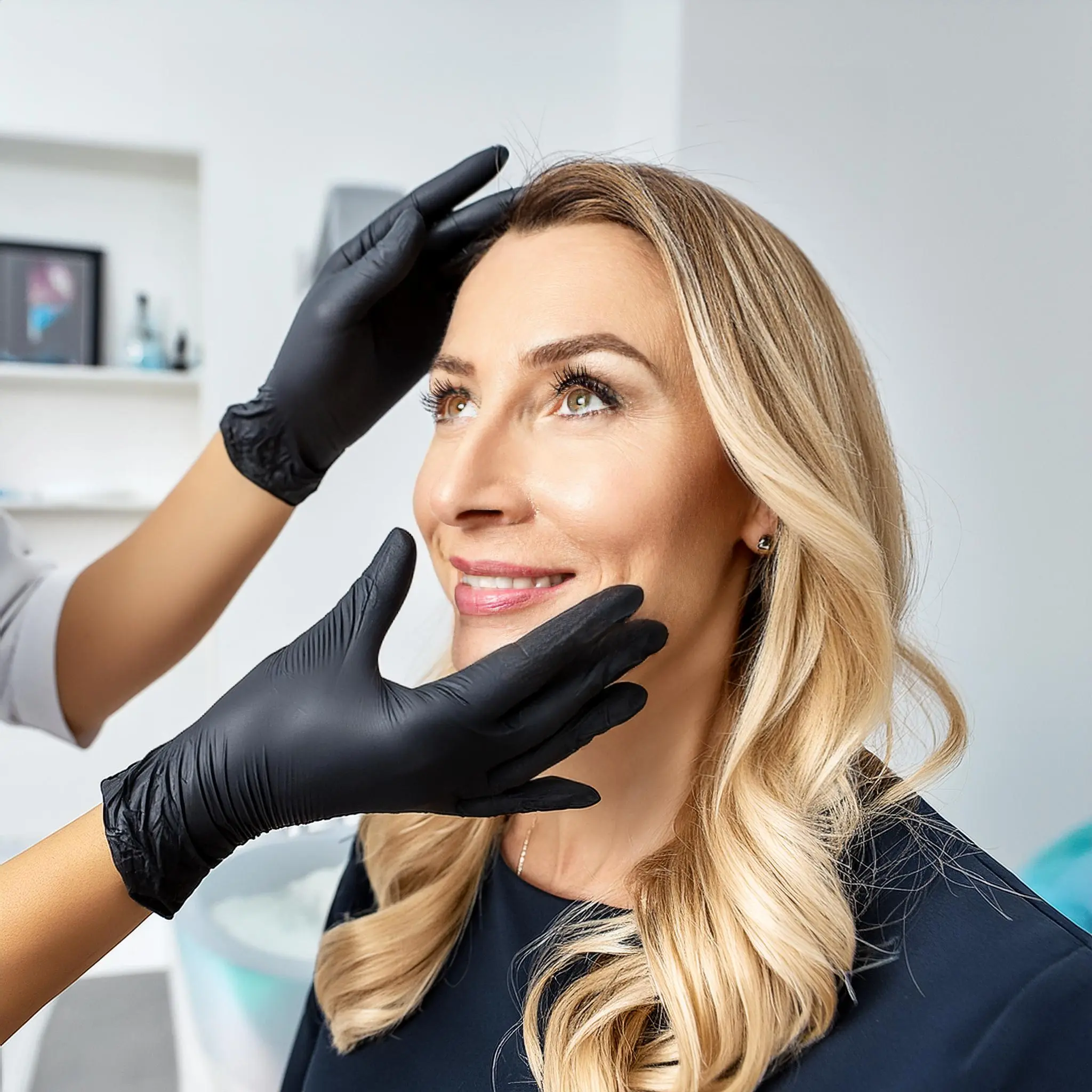Skin Tightening Treatments

Volume Loss and Sagging Skin
Volume loss, accompanied by sagging, is a natural part of the aging process that can significantly influence our facial aesthetics. As the years pass, the skin experiences changes, leading to a decrease in collagen, fat, and overall facial fullness, resulting in noticeable sagging. This diminishing volume and sagging contribute to the formation of wrinkles, fine lines, and a loss of the natural contours that define a youthful appearance. The significance of maintaining facial volume, especially in combating sagging, goes beyond mere aesthetics; it plays a crucial role in how we perceive ourselves and how others perceive us. Facial volume contributes to the harmony and balance of our features, reflecting vitality and vigor. In this article, we’ll delve into the causes and signs of volume loss and sagging, explore its effects on self-esteem, and discuss various non-surgical and surgical options available to restore and enhance facial volume while addressing sagging. Understanding the importance of addressing volume loss and sagging is the first step towards embracing effective solutions for a revitalized and confident version of ourselves.
As we age, our skin undergoes natural changes, including a reduction in collagen and fat, crucial components that provide structure and fullness, ultimately leading to sagging. Sun exposure, another significant factor, accelerates this process, exacerbating premature aging and volume depletion, resulting in noticeable sagging. Lifestyle choices, such as smoking, can further contribute to the breakdown of collagen and the loss of facial plumpness, exacerbating sagging effects. Additionally, genetic predispositions play a role in how our faces age, with some individuals being more prone to volume loss and sagging due to inherited traits. Understanding these diverse causes helps us comprehend the multifaceted nature of volume loss and underscores the importance of proactive measures to preserve facial fullness and overall skin health while addressing sagging concerns.
Volume loss in the face manifests through various distinctive signs and symptoms, which collectively contribute to changes in facial aesthetics. One noticeable indication is the hollowing of specific facial areas, such as the cheeks, temples, and under eyes, where a once-plump appearance may give way to subtle concavity. As collagen and fat diminish, wrinkles and fine lines become more pronounced, accentuating the aging process. Another common symptom is the overall loss of facial fullness and contours, resulting in a less youthful and vibrant look. Recognizing these signs early on is crucial for individuals concerned about volume loss, as it can prompt proactive measures to address these changes and restore a more rejuvenated appearance.
Volume loss doesn't only affect the physical appearance but can also have significant emotional implications. The changes in facial volume often impact an individual's self-esteem, influencing how they perceive themselves. As facial contours shift and wrinkles emerge, one may experience a decrease in confidence and overall well-being. However, the positive aspect is that addressing volume loss through appropriate treatments can have a transformative effect on self-esteem. Restoring lost volume not only rejuvenates the face but also contributes to a renewed sense of confidence and positive self-perception. Understanding the emotional impact of volume loss underscores the holistic nature of aesthetic concerns, emphasizing the importance of both physical and psychological well-being in the pursuit of a more youthful appearance.
At FCP Dermatology we offer a wide range of surgical and cosmetic Dermatology services, in a 5-star luxury setting.
- +1 (416) 861-8600
- Contact Us
Skin Tightening Treatments
Skin Boosters
Sculptra
Fillers
Related Aging and Skin Concerns
- Dermal Fillers: Dermal fillers offer a non-surgical solution to combat volume loss, effectively replenishing areas affected by sagging or wrinkles. These injectables, often containing substances like hyaluronic acid, provide immediate volume and smoothness, reducing the appearance of fine lines. There are various types of dermal fillers, each tailored for specific applications. Whether addressing hollow cheeks or nasolabial folds, dermal fillers can be customized to meet individual needs. Their safety and effectiveness make them a popular choice for those seeking a non-invasive yet impactful solution.
- Skin Boosters: Skin boosters work by delivering hydration and essential nutrients to the skin, enhancing its overall quality and radiance. These treatments involve injections of specialized formulas that promote collagen production and improve skin elasticity. Skin boosters are particularly beneficial for individuals dealing with dullness, fine lines, and loss of facial volume. The hydrating effects contribute to a refreshed and rejuvenated appearance, making skin boosters a valuable component of non-surgical volume loss treatments.
- Sculptra: Sculptra stands out for its collagen-stimulating properties, offering a gradual and natural-looking approach to volume restoration. This injectable contains poly-L-lactic acid, which encourages the body to produce collagen over time. As collagen levels increase, the skin gains firmness and elasticity. Sculptra is an ideal option for individuals seeking a subtle and progressive improvement in facial volume. Its ability to stimulate collagen sets it apart, providing lasting results that develop gradually for a more authentic rejuvenation.
Surgical Treatment Options
Surgical interventions may be considered for more extensive volume loss in conjunction with non-surgical options. Surgery has considerable downtime, carries many more risks, requires general anesthesia (which has its own risks), and it is much more difficult to correct. In addition, surgery alone will not be enough to correct facial volume issues and dermal fillers will still be required.
Safety Considerations
Ensuring safety is paramount when considering volume restoration treatments. It’s natural for individuals to have concerns, but it’s crucial to emphasize that dermal fillers, skin boosters, Sculptra, and surgical procedures are generally safe when administered by qualified physicians. Reputable dermatologists prioritize patient safety, providing a thorough assessment of individual health factors before recommending any treatment. Seeking the expertise of these qualified doctors ensures that the chosen approach aligns with the patient’s needs and health considerations, ultimately contributing to a safe and successful volume restoration experience.
View Available Treatments
Skin Tightening Treatments
Choosing the Right Treatment
When addressing volume loss, choosing the right treatment involves careful consideration of various factors. Individuals should weigh the extent of volume loss, their aesthetic goals, and preferences. Consulting with a dermatologist is crucial for personalized advice, as these professionals can assess individual needs and recommend the most suitable approach. Non-surgical options like dermal fillers, skin boosters, and Sculptra offer effective and less invasive solutions, while surgical interventions, such as facelifts, may be considered but carry more risk, more downtime, and do not negate the need for dermal fillers. Ultimately, the decision should align with individual concerns and be guided by expert advice to achieve optimal and satisfying results.
Navigating the recovery and results aspect is essential when addressing volume loss. For non-surgical treatments like dermal fillers, skin boosters, and Sculptra, the recovery process is typically minimal, with possible short-term swelling or bruising that subsides quickly. Results often become noticeable shortly after the procedure, contributing to a refreshed appearance. On the other hand, surgical options, such as facelifts, may involve a more extended recovery period, with gradual improvements becoming apparent over weeks to months. Setting realistic expectations for the timeline of visible results is key, ensuring individuals are well-informed about the journey toward restored facial volume and the transformation it brings to their overall look.
Skin Tightening Treatments
Lifestyle Tips for Maintenance
Sustaining the results of volume restoration is crucial for a long-lasting youthful appearance. After undergoing non-surgical treatments like dermal fillers, skin boosters, and Sculptra, adopting a diligent post-treatment care routine becomes essential. Simple practices such as protecting the skin from sun exposure and adhering to a skincare routine contribute significantly to maintaining the rejuvenated look. These measures, coupled with post-treatment care instructions from qualified professionals, enhance the longevity of the aesthetic improvements achieved through volume restoration.

Sagging Skin FAQ
Frequently Asked Questions about Volume Loss and Sagging Skin
- Volume loss refers to the depletion of fat and collagen in specific facial areas, leading to a loss of fullness and contours.
The aging process accelerates collagen and fat depletion, contributing to diminished facial volume.
Yes, prolonged sun exposure and lifestyle choices can accelerate volume loss by affecting collagen and elastin.
Genetic factors can play a role in an individual's susceptibility to volume loss.
Signs include hollowing in facial areas, pronounced wrinkles, and an overall loss of facial fullness.
Volume loss can affect self-perception, and restoring volume often enhances confidence and well-being.
Consider factors like personal preferences for risk and downtime and consult with a physician for advice.
Recovery varies, but generally, it involves minimal to no downtime, allowing a quick return to regular activities.
Visible results depend on the treatment, but many non-surgical procedures show immediate effects, with improvements over time.
Seeking qualified doctors (ideally a Dermatologist) ensures the safety of volume restoration treatments.
Post-treatment care, sun protection, and a good skin care plan contribute to prolonged results.
Physicians are the only medical professionals qualified to provide safe treatment and personalized advice.
